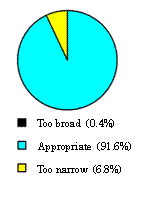|
Status of Reception etc. of Consultation Requests at
''Counseling Office for Financial Services Users''
|
|
| 1. |
Background |
|
On July 19 of this year, the Financial Services Agency (FSA) started operating the
''Counseling Office for Financial Services Users'' (hereinafter referred to as the
''Counseling Office'') to receive, under a one-stop umbrella, inquiries, consultation requests and comments, etc. concerning financial services, etc. (hereinafter referred to as
''consultation requests, etc.'') from users, in an attempt to augment the level of convenience for financial services users and utilize the received information for financial administration purposes in an effective fashion.
Data such as the number of consultation requests received by the Counseling Office from users and points of major consultation cases are scheduled to be released to the public on a quarterly basis; the recent release (dated October 27) is data on the period between July 19, the first day of Consulting Office operations, and September 30.
|
| 2. |
Public Release Outline |
|
(1) |
We received a total of 6,573 consultation requests, etc. between July 19 and September 30, which makes the average number of consultation requests, etc. 126 a day. |
|
(2) |
The distribution of consultation requests, etc. by subject is: 1,774 (27%) on depositing and financing, etc.; 2,487 (38%) on insurance products etc.; 1,534 (23%) on investment products, etc.; 660 (10%) on cash loans, etc. and 118 (2%) on other issues. |
|
(3) |
The characteristics, etc. found in each subject area are as follows: |
|
|
a. |
On the subject of depositing and financing, etc.: Consultation requests, etc. with respect to deposit services included general questions, etc. about the system of explanation at the time of making a deposit, as well as about the pay-off scheme and counterfeit or stolen cash cards; the implementation and repayment of financing was among the cases brought on the subject of financing services. |
|
|
b. |
On the subject of insurance products, etc: Many consultation requests, etc. concerned insurance payments, etc.; responses from insurance companies at the time of filing insurance claims, etc.; and the system of explanation on the part of insurance companies at the time of solicitation, etc. |
|
|
c. |
On the subject of investment products, etc.: Many consultation
requests, etc. concerned foreign exchange margin trading, computer
system trouble at Internet-based securities companies, and trading of
unlisted shares, etc. |
|
|
d. |
On the subject of cash loans, etc.: Many consultation requests, etc.
concerned with inquiries about the existence of the moneylender
registration, and improper conducts, etc. |
|
(4) |
Of the consultation requests, etc. that the Counseling Office received, seven major cases, one from each subject area, are presented as
''Consultation Case Examples, etc. and Advice, etc.'' |
|
|
(Reference) Details of the seven case examples |
|
|
|
a. |
Supply of information on financial institution accounts used by illicit businesses |
|
|
|
b. |
Consultation request, etc. concerning explanation provided to customers regarding insurance details |
|
|
|
c. |
Consultation request, etc. concerning the duty of disclosure |
|
|
|
d. |
Consultation request, etc. concerning insurance payments |
|
|
|
e. |
Consultation request, etc. concerning foreign exchange margin trading |
|
|
|
f. |
Consultation request, etc. concerning trading of unlisted shares |
|
|
|
g. |
Consultation request, etc. concerning borrowing from illegal moneylenders, etc. |
|
(5) |
As the consultation requests, etc. received also contained some information that can be useful for inspection and supervision purposes (see Note), the FSA values and uses such information in its financial administration on an as-required basis, from a perspective of protecting users and augmenting the level of convenience for users as a whole, including supplying it to relevant agencies and conducting interviews with financial institutions named therein. |
|
|
(Note) Information that can be useful for inspection and supervision purposes |
|
|
|
a. |
Information supplied with respect to lending crunch or oppressive debt collection |
|
|
|
b. |
Information supplied with respect to financial institution accounts used by illicit businesses |
|
|
|
c. |
Consultation requests, etc. with respect to improper conduct by foreign exchange margin trading businesses (e.g., solicitation for customers with no investment experience, presentation of categorical judgments, unauthorized sale/purchase, delayed refund of the balance, etc.) |
|
|
|
d. |
Consultation requests, etc. with respect to improper conduct by insurance company salespersons, etc. (e.g., subornation of non-disclosure, advance payment of insurance premiums, unauthorized agreement establishment, use of someone's identity, etc.)
|
| 3. |
Approach to Future Actions |
|
In line with the fact that the Counseling Office was established in order to serve as part of the efforts to achieve the purpose of
''Strengthening the framework for providing information and counseling in order to protect users,''
one of the measures stated in the ''Program for Further Financial Reform,'' the FSA is committed to continuing the appropriate operation of the Counseling Office so that
''a financial system in which the level of users' satisfaction is high'' will be realized, as the
''Program for Further Financial Reform'' describes as a vision of a desirable financial system for the future. |
|
|
Amendment to Administrative Guidelines (Volume III: For Non-Bank Finance Companies): clarification of Moneylenders' Obligation to Disclose Transaction History |
|
1. |
Introduction |
|
Following a Supreme Court decision upholding that ''moneylenders are obliged to disclose transaction history,'' the Financial Services Agency amended the Administrative Guidelines for the moneylending business (Volume III: For Non-Bank Finance Companies) with intentions to clearly specify the obligation to disclose transaction history under the
''Money-Lending Business Control and Regulation Law'' and also to specify personal identification procedures to be used at the time of disclosure. The circumstances leading up to the recent amendment will be explained below, together with the overview of the amendment. |
2. |
Circumstances Leading Up to the Guidelines' Amendment |
|
The Supreme Court upheld its decision on July 19 this year of the Third Petty Bench that moneylenders, under the duty of good faith, are obliged to disclose transaction history based on the business ledgers that they maintain, as part of their obligation to loan agreements, that are subject to the Money-Lending Business Control and Regulation Law.
In this regard, paragraph 2 of Article 13 of the Money-Lending Business Control and Regulation Law stipulates the prohibition of any deceit or using any unfair or extremely undue means in lending, or managing a loan or taking measures for collection in conjunction with the lending agreement. As
''unfair'' means ''unlawful'' (as in the main text of Section 3-2-2 of the Guidelines), unlawful refusal of transaction history disclosure is an act that the Supreme Court has found to violate the duty of good faith (under paragraph 2, Article 1 of the Civil Code), which would constitute the use of unfair means in managing a loan in connection with a lending agreement and could be subject to administrative actions. The recent amendment to the Guidelines was intended to clearly specify and raise the awareness of how the Money-Lending Business Control and Regulation Law is to be applied in accordance with the Supreme Court's decision as described above.
In addition to the above consideration, we also proceeded to create in the amended Guidelines, provisions specific points to be noted by moneylenders in taking personal identification procedures when they are requested to disclose transaction history. Seeing that transaction history is also personal information, adequate and appropriate personal identification procedures are required in disclosure so that it should not be unduly passed on to a third party; in reality, however, this practice was disoriented, as to how strict such personal identification procedures should be conducted and some businesses would supposedly impose excessive burdens on requesters. In the recent amendment, the fundamental approach is clearly stated initially that moneylenders should not impose excessive burdens on requesters, and from this aspect, it specifies matters that moneylenders should pay attention to.
Following public comments sought between August 12 and September 2, the amendment was released to the public on October 14 and came into force as of November 14. The results of the public comments were also released on October 14, in which we provided detailed explanations of various matters in answer to comments received; we hope that they will be referred to in connection with this article. |
3. |
Amendment Overview |
|
(1) |
Clear specification of the obligation to disclose transaction history (re: Section 3-2-2(6) of the Guidelines) |
|
|
Section 3-2-2(6) of the Guidelines stipulates that where a customer; or a party who intends to serve as a guarantee obligation on behalf of another customer; or a party who, upon obtaining consent from another customer, intends to serve as an obligation on behalf of that customer (hereinafter referred to as
''customer, etc.''); or a representative for the customer, etc., requests the disclosure of transaction history in order to accurately comprehend the details of the debt, such as for the purpose of checking the amount of the debt, unduly refusing such a request is quite likely to be an act prohibited under paragraph 2 of Article 13 of the Money-Lending Business Control and Regulation Law.
As also described in our answers to public comments, what is very likely to constitute a violation of the Money-Lending Business Control and Regulation Law is the act of
''unduly'' refusing disclosure. ''Undue refusal'' in this case has two implications. The first implication is that even if the act does not formally constitute refusal, by effectively refusing the disclosure, it is treated as a refusal. For instance, a moneylender's actions for imposing excessive or unnecessary personal identification requirements would be considered such a case if it did so, despite the fact that personal identification is possible by means that are less burdensome to the customer, etc. The other implication is that a moneylender may refuse the disclosure under certain circumstances, in which case such refusal would not constitute
''undue refusal.'' For instance, a moneylender's refusal of the disclosure would presumably not constitute undue refusal if the request was made by someone who is not qualified as a lawyer, etc., whose purpose is to earn fees for debt arrangements.
|
|
(2) |
Personal identification procedures in connection with disclosure (re: Section 3-2-8(1) of the Guidelines) |
|
|
As already explained, a customer, etc., may request the disclosure of transaction history on the grounds of moneylenders' obligation of disclosure under good faith. Although grounds for disclosure request in such a case does not rest with the Personal Information Protection Law, the moneylender needs to take certain forms of personal identification procedures, due to transaction history being considered as personal information. By taking such personal identification procedures, however, the moneylender should not impose excessive burdens on the person requesting the disclosure. Upon clearly specifying such fundamental approach and taking into consideration the request and confirmation procedures that have been traditionally established as reasonable in practice, the Guidelines provide a list of matters to be noted in personal identification procedures.
The numbering in the square brackets in the following texts show the corresponding sections in the Guidelines. |
|
|
(1) |
When a customer, etc., personally requests the disclosure |
|
|
|
It would presumably be appropriate to ask for the presentation of a document verifying identity (driver's license, etc.) required under the Customer Identification Law, if for instance, the person requesting the disclosure has no past commercial relationship with the moneylender or if there is nothing suspicious about the matter described in the document at the time of the request [3-2-8(1)1)a].
If, on the other hand, the person requesting the disclosure is in a commercial relationship with the moneylender and there are other methods that are less burdensome to the requester, such as checking his identity by referring to information, etc., stated in business documents retained by the moneylender (e.g., the customer's name and customer number), it would be appropriate to conduct personal identification by that method [main text of and note to 3-2-8(1)1)b].)
If the moneylender receives a disclosure request during a meeting or phone conversation with the customer, etc., it would be inappropriate, given that personal identification has already been carried out, to ask again for identity verification. [3-2-8(1)1)c].
|
|
|
(2) |
When a representative for the customer, etc., requests the disclosure |
|
|
|
In the case of disclosure request through a representative, it is necessary to check threeconditions: (i) the customer, etc., requesting the disclosure is the very person connected with the transaction history being requested to be disclosed; (ii) the said customer, etc., has authorized the representative; and (3) the person requesting the disclosure is the representative himself. Particularly for condition (i), appropriate action would be to use a method of identification, if any, that is less burdensome to the customer, etc., as in the case of a customer, etc., personally requesting the disclosure [3-2-8(1)2)].
|
|
|
(3) |
When a lawyer or a shiho shoshi lawyer requests the disclosure in the capacity of representative for the customer, etc. |
|
|
|
While a lawyer or a shiho shoshi lawyer is assumed to be more trustworthy than a representative with no such qualification, certain forms of verification may still be deemed necessary; therefore, the recently amended Guidelines provides a list of points to note, which was developed while also considering the practice that has been widely applied.
First, with respect to checking the authorization relationship, it is not necessary to ask for the presentation of the power of attorney if the authorization relationship can be presumed from the fact, for instance, that the moneylender received a notice from the lawyer or the shiho shoshi lawyer specifying that he had been authorized by the customer, etc., in the disclosure request (including a notice of representation concerning debt arrangements) and that the personal verification of the customer, etc., described in that notice is sufficient, unless there is anything particularly suspicious [3-2-8(1)3)a]. In the case of the presentation of a so-called notice of representation used in practice, it would not be necessary to present another document showing the authorization relationship, if that notice contains sufficient personal verification of the customer, etc., unless there is anything suspicious, such as an inconsistency between the information in the notice and the matter in the documents retained by the moneylender.
With respect to personal verification of the representative, it is not necessary to ask for identity verification of the representative if the disclosure request produced by the lawyer or a shisho shoshi lawyer contains his/her contact information, including the address of the firm, given that it is possible to check his/her identity by referring to the bar association or a shiho shoshi lawyer's association, unless there is anything particularly suspicious [3-2-8(1)3)b].
Lastly, it is inappropriate to ask again for identity verification or the power of attorney if, during a meeting or phone conversation between the moneylender and the customer, etc., the latter has expressed his/her intention to authorize a representative in the disclosure request or debt arrangement, etc., and the representative who is a lawyer or a shiho shoshi lawyer has without delay given notice of representation, unless there is anything particularly suspicious [3-2-8(1)3)c].
|
| 4. |
Conclusion |
|
In the above text, we have explained the amendment to the Guidelines with respect to the disclosure of transaction history. As transaction history is a significant piece of information for a customer, etc., to accurately comprehend the details of the debt, it will contribute to the customers' protection if moneylenders comply with the amended Guidelines and appropriately address disclosure requests from customers, etc.; at the same time, it is expected that the resulting improvements in the transparency of their operation, together with the customers' sense of reassurance that they can always check their transaction history if need be, will lead to greater trust in the moneylending business. |
|
|









